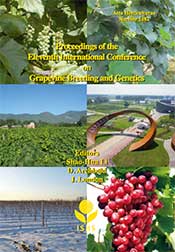Ver ítem
- xmlui.general.dspace_homeCentros Regionales y EEAsCentro Regional Mendoza - San JuanEEA MendozaArtículos científicosxmlui.ArtifactBrowser.ItemViewer.trail
- Inicio
- Centros Regionales y EEAs
- Centro Regional Mendoza - San Juan
- EEA Mendoza
- Artículos científicos
- Ver ítem
Nucleotide sequence of key genes from the biosynthesis pathway of the major flavonoid in “Malbec” and “Cabernet Sauvignon”
Resumen
In red wines, important sensory attributes such as color and astringency are the result of the accumulation of anthocyanins, which are located in the berry skin (and in the pulp of teinturier cultivars). Each cultivar has a unique set of
anthocyanins and both qualitative and qualitative anthocyanin composition at
harvest are crucial factors for winemaking. Anthocyanins are synthesized through the so-called phenylpropanoid pathway. Vitis vinifera L.
[ver mas...]
In red wines, important sensory attributes such as color and astringency are the result of the accumulation of anthocyanins, which are located in the berry skin (and in the pulp of teinturier cultivars). Each cultivar has a unique set of
anthocyanins and both qualitative and qualitative anthocyanin composition at
harvest are crucial factors for winemaking. Anthocyanins are synthesized through the so-called phenylpropanoid pathway. Vitis vinifera L. ‘Malbec’ and ‘Cabernet
Sauvignon’ are red cultivars adapted to similar environmental conditions. Both cultivars are usually cropped to have from medium to low yields to ensure the production of premium and ultra-premium wines. Although ‘Malbec’ has significant differences in the dihydroflavonol concentration, being 10 times higher than in other red cultivars such as ‘Cabernet Sauvignon’, this increment could be partially explained by differences in the gene sequences coding for enzymes working between the naringenin chalcone and leucoanthocyanins steps. In order to investigate the dynamics of anthocyanin accumulation in grapevines, we sequenced cDNAs coding for enzymes of the anthocyanin biosynthetic pathway isolated from grape berry skin, sampled throughout ripening from two selected clones of ‘Malbec’ and ‘Cabernet Sauvignon’. Specific primers were synthesized using EST sequences (NCBI) for flavonoid 3’5’-hydroxylase, flavanone 3-hydroxylase, flavonol synthase and dihydroflavonol 4-reductase. Total RNA was isolated from berry skins and cDNA was used to study these gene sequences. Finally, fragments were cloned and sequenced, and compared between cultivars. The comparison of the deduced aminoacidic sequences against the reference data base show identities higher than 99% with the cultivar ‘Pinot Noir’ for all the enzymes, and the identified mutations do not seem to have any effect on the protein structure. When a comparison between ‘Malbec’ and ‘Cabernet Sauvignon’ sequences was performed, the identity was also higher than 99%. Our results are the basis for future investigation on the specific gene expression, and also can be used as a trigger for future assays focused on understanding the modulator effect produced by the environment on the genotypes of these worldwide cultivars.
[Cerrar]

Fuente
Acta horticulturae 1082 : 347-352. (2015)
Fecha
2015
ISSN
0567-7572
Formato
pdf
Tipo de documento
artículo
Palabras Claves
Derechos de acceso
Restringido
 Excepto donde se diga explicitamente, este item se publica bajo la siguiente descripción: Creative Commons Attribution-NonCommercial-ShareAlike 2.5 Unported (CC BY-NC-SA 2.5)
Excepto donde se diga explicitamente, este item se publica bajo la siguiente descripción: Creative Commons Attribution-NonCommercial-ShareAlike 2.5 Unported (CC BY-NC-SA 2.5)

